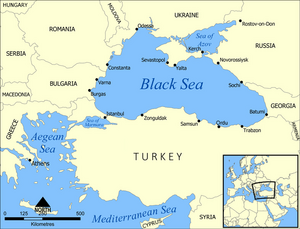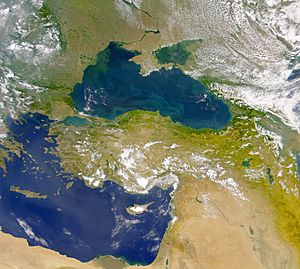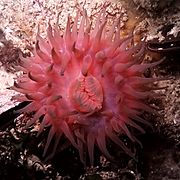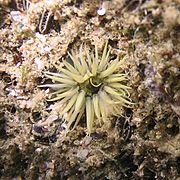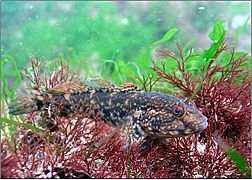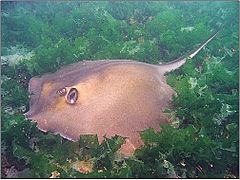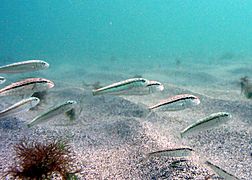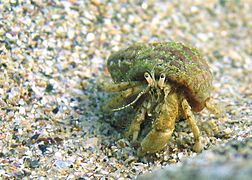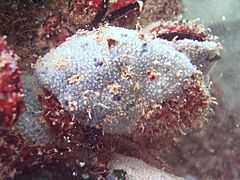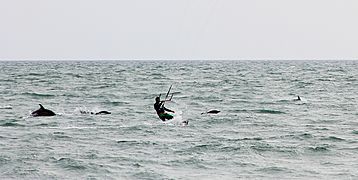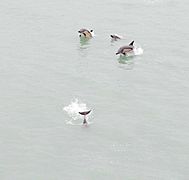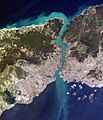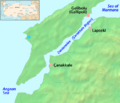Black Sea facts for kids
The Black Sea is a sea in Eurasia between Europe, Caucasus, and Anatolia. Many big rivers connect to the Black Sea, like Don, Danube, and Dnieper rivers.
It is connected to the Atlantic ocean through the Mediterranean Sea, Aegean Sea, and many straits. 90% of the sea has no oxygen. The water is saltwater but less salty than the ocean. During the last ice age, the Black Sea was a freshwater lake.
Contents
History
In Greek mythology, the Argonauts traveled on the sea. Greeks set up colonies around the sea because it was important to trade for many countries in ancient history. The Gallipoli Campaign during World War I was a fight for access to the Black Sea. It was also important in World War II.
Geology
The Black Sea sits on continental plates which have subsided. It is a geologic basin, and therefore is a genuine inland sea. Its maximum depth is about 2000 metres. The Black Sea is the world’s largest basin where the deep waters do not mix with the upper layers of water that receive oxygen from the atmosphere. As a result, over 90% of the deeper Black Sea volume is anoxic water. The upper layers are generally cooler, less dense and less salty than the deeper waters, as they are fed by large river systems, whereas the deep waters come from the warm, salty waters of the Mediterranean. The Crimean Peninsula divides this sea. The Bosporus and Dardanelles connect the Black Sea to the Mediterranean.
Hydrology
The Black Sea is a marginal sea and is the world's largest body of water with a meromictic basin. The deep waters do not mix with the upper layers of water that receive oxygen from the atmosphere. As a result, over 90% of the deeper Black Sea volume is anoxic water. The Black Sea's circulation patterns are primarily controlled by basin topography and fluvial inputs, which result in a strongly stratified vertical structure. Because of the extreme stratification, it is classified as a salt wedge estuary.
The Black Sea only experiences water transfer with the Mediterranean Sea, so all inflow and outflow occurs in the Bosphorus and Dardanelles. Inflow from the Mediterranean has a higher salinity and density than the outflow, creating the classical estuarine circulation. This means that inflow of dense water from Mediterranean occurs at the bottom of the basin while outflow of fresher Black Sea surface-water into the Marmara Sea occurs near the surface. Fresher surface water is the product of the fluvial inputs, and this makes the Black Sea a positive sea. The net input of freshwater creates an outflow volume about twice that of the inflow. Evaporation and precipitation are roughly equal at about 300 cubic kilometres per year (72 cu mi/a).
Because of the narrowness and shallowness of the Bosphorus and Dardanelles (their respective depths are only 33 and 70 meters), inflow and outflow current speeds are high and there is significant vertical shear. This allows for turbulent mixing of the two layers. Surface water leaves the Black Sea with a salinity of 17 psu and reaches the Mediterranean with a salinity of 34 psu. Likewise, inflow of the Mediterranean with salinity 38.5 psu experiences a decrease to about 34 psu.
Mean surface circulation is cyclonic and waters around the perimeter of the Black Sea circulate in a basin-wide shelfbreak gyre known as the Rim Current. The Rim Current has a maximum velocity of about 50–100 cm/s. Within this feature, two smaller cyclonic gyres operate, occupying the eastern and western sectors of the basin. The Eastern and Western Gyres are well-organized systems in the winter but dissipate into a series of interconnected eddies in the summer and autumn. Mesoscale activity in the peripheral flow becomes more pronounced during these warmer seasons and is subject to interannual variability.
Outside of the Rim Current, numerous quasi-permanent coastal eddies are formed as a result of upwelling around the coastal apron and "wind curl" mechanisms. The intra-annual strength of these features is controlled by seasonal atmospheric and fluvial variations. During the spring, the Batumi eddy forms in the southeastern corner of the sea.
Beneath the surface waters—from about 50–100 meters—there exists a halocline that stops at the Cold Intermediate Layer (CIL). This layer is composed of cool, salty surface waters, which are the result of localized atmospheric cooling and decreased fluvial input during the winter months. It is the remnant of the winter surface mixed layer. The base of the CIL is marked by a major pycnocline at about 100–200 metres (330–660 ft) and this density disparity is the major mechanism for isolation of the deep water.
Below the pycnocline is the Deep Water mass, where salinity increases to 22.3 psu and temperatures rise to around 8.9 °C. The hydrochemical environment shifts from oxygenated to anoxic, as bacterial decomposition of sunken biomass utilizes all of the free oxygen. Weak geothermal heating and long residence time create a very thick convective bottom layer.
Hydrochemistry
Because of the anoxic water at depth, organic matter, including anthropogenic artifacts such as boat hulls, are well preserved. During periods of high surface productivity, short-lived algal blooms form organic rich layers known as sapropels. Scientists have reported an annual phytoplankton bloom that can be seen in many NASA images of the region. As a result of these characteristics the Black Sea has gained interest from the field of marine archaeology as ancient shipwrecks in excellent states of preservation have been discovered, such as the Byzantine wreck Sinop D, located in the anoxic layer off the coast of Sinop, Turkey.
Modelling shows the release of the hydrogen sulphide clouds in the event of an asteroid impact into the Black Sea would pose a threat to health—or even life—for people living on the Black Sea coast.
There have been isolated reports of flares on the Black Sea occurring during thunderstorms, possibly caused by lightning igniting combustible gas seeping up from the sea depths.
Ecology
Marine
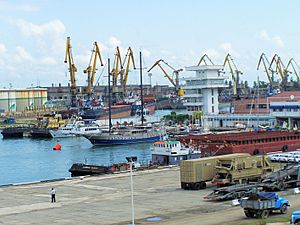
The Black Sea supports an active and dynamic marine ecosystem, dominated by species suited to the brackish, nutrient-rich, conditions. As with all marine food webs, the Black Sea features a range of trophic groups, with autotrophic algae, including diatoms and dinoflagellates, acting as primary producers. The fluvial systems draining Eurasia and central Europe introduce large volumes of sediment and dissolved nutrients into the Black Sea, but distribution of these nutrients is controlled by the degree of physiochemical stratification, which is, in turn, dictated by seasonal physiographic development.
During winter, strong wind promotes convective overturning and upwelling of nutrients, while high summer temperatures result in a marked vertical stratification and a warm, shallow mixed layer. Day length and insolation intensity also controls the extent of the photic zone. Subsurface productivity is limited by nutrient availability, as the anoxic bottom waters act as a sink for reduced nitrate, in the form of ammonia. The benthic zone also plays an important role in Black Sea nutrient cycling, as chemosynthetic organisms and anoxic geochemical pathways recycle nutrients which can be upwelled to the photic zone, enhancing productivity.
Phytoplankton
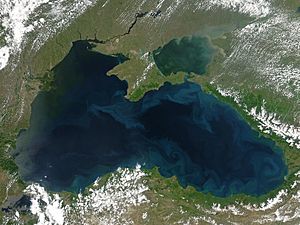
The main phytoplankton groups present in the Black Sea are dinoflagellates, diatoms, coccolithophores and cyanobacteria. Generally, the annual cycle of phytoplankton development comprises significant diatom and dinoflagellate-dominated spring production, followed by a weaker mixed assemblage of community development below the seasonal thermocline during summer months and a surface-intensified autumn production. This pattern of productivity is also augmented by an Emiliania huxleyi bloom during the late spring and summer months.
Animal species
- The Black Sea along with the Caspian Sea is part of the Zebra mussel's native range. The mussel has been accidentally introduced around the world and become an invasive species where it has been introduced.
- The Common Carp's native range extends to The Black Sea along with the Caspian Sea and Aral Sea. Like the Zebra mussel the Common Carp is an invasive species when introduced to other habitats.
- Round Goby
- Is another native fish that is also found in the Caspian Sea. It preys upon Zebra mussels. Like the mussels and common carp it has become invasive when introduced to other environments, like the Great Lakes.
- Marine Mammals and marine megafaunas
- Marine mammals present within the basin include two species of dolphins (common and bottlenose) and harbour porpoise inhabit the sea although all of these are endangered due to pressures and impacts by human activities. All the three species have been classified as a distinct subspecies from those in the Mediterranean and in Atlantic Seas and endemic to Black and Azov Seas. However, construction of the Kerch Strait Bridge caused increases in nutrients and planktons in the waters, attracting large numbers of fish and more than 1,000 of bottlenose dolphins.
- Critically endangered Mediterranean monk seals were historically abundant in Black Sea, and are regarded to have become extinct from the basin since in 1997.
- Various species of pinnipeds, sea otter, and beluga whales were introduced into Black Sea by mankind and later escaped either by accidental or purported causes. Of these, grey seal and beluga whales have been recorded with successful, long-term occurrences.
Ecological effects of pollution
Since the 1960s, rapid industrial expansion along the Black Sea coast line and the construction of a major dam has significantly increased annual variability in the N:P:Si ratio in the basin. In coastal areas, the biological effect of these changes has been an increase in the frequency of monospecific phytoplankton blooms, with diatom bloom frequency increasing by a factor of 2.5 and non-diatom bloom frequency increasing by a factor of 6. The non-diatoms, such as the prymnesiophytes [Emiliania huxleyi] Error: {{Lang}}: text has italic markup (help) (coccolithophore), [Chromulina] Error: {{Lang}}: text has italic markup (help) sp., and the Euglenophyte [Eutreptia lanowii] Error: {{Lang}}: text has italic markup (help) are able to out-compete diatom species because of the limited availability of Si, a necessary constituent of diatom frustules. As a consequence of these blooms, benthic macrophyte populations were deprived of light, while anoxia caused mass mortality in marine animals.
The decline in macrophytes was further compounded by overfishing during the 1970s, while the invasive ctenophore Mnemiopsis reduced the biomass of copepods and other zooplankton in the late 1980s. Additionally, an alien species—the warty comb jelly ([Mnemiopsis leidyi] Error: {{Lang}}: text has italic markup (help))—was able to establish itself in the basin, exploding from a few individuals to an estimated biomass of one billion metric tons. The change in species composition in Black Sea waters also has consequences for hydrochemistry, as Ca-producing coccolithophores influence salinity and pH, although these ramifications have yet to be fully quantified. In central Black Sea waters, Si levels were also significantly reduced, due to a decrease in the flux of Si associated with advection across isopycnal surfaces. This phenomenon demonstrates the potential for localised alterations in Black Sea nutrient input to have basin-wide effects.
Pollution reduction and regulation efforts have led to a partial recovery of the Black Sea ecosystem during the 1990s, and an EU monitoring exercise, 'EROS21', revealed decreased N and P values, relative to the 1989 peak. Recently, scientists have noted signs of ecological recovery, in part due to the construction of new sewage treatment plants in Slovakia, Hungary, Romania, and Bulgaria in connection with membership in the European Union. [Mnemiopsis leidyi] Error: {{Lang}}: text has italic markup (help) populations have been checked with the arrival of another alien species which feeds on them.
-
Hermit crab, Diogenes pugilator
-
Endangered Black Sea Common Dolphins with a kite-surfer off Sochi
-
Common dolphins porpoising with a ferry at Batumi port
Images for kids
-
Swallow's Nest in Crimea
-
A sanatorium in Sochi, Russia
-
Coast of the Black Sea at Ordu
-
The Black Sea near Constanța, Romania
-
The Bosporus, taken from the International Space Station
-
Map of the Dardanelles
-
Ivan Aivazovsky. Black Sea Fleet in the Bay of Theodosia, just before the Crimean War
See also
 In Spanish: Mar Negro para niños
In Spanish: Mar Negro para niños


